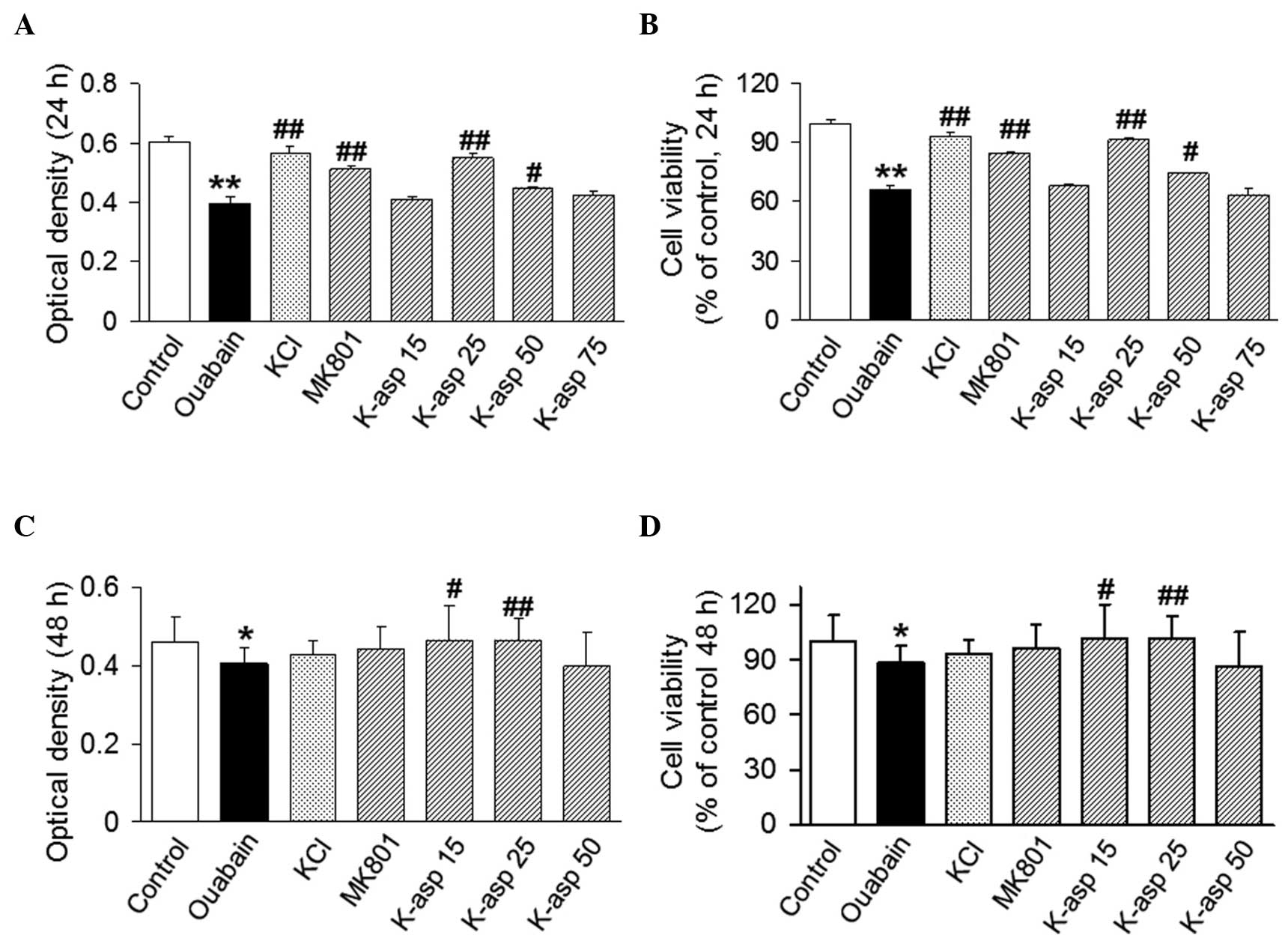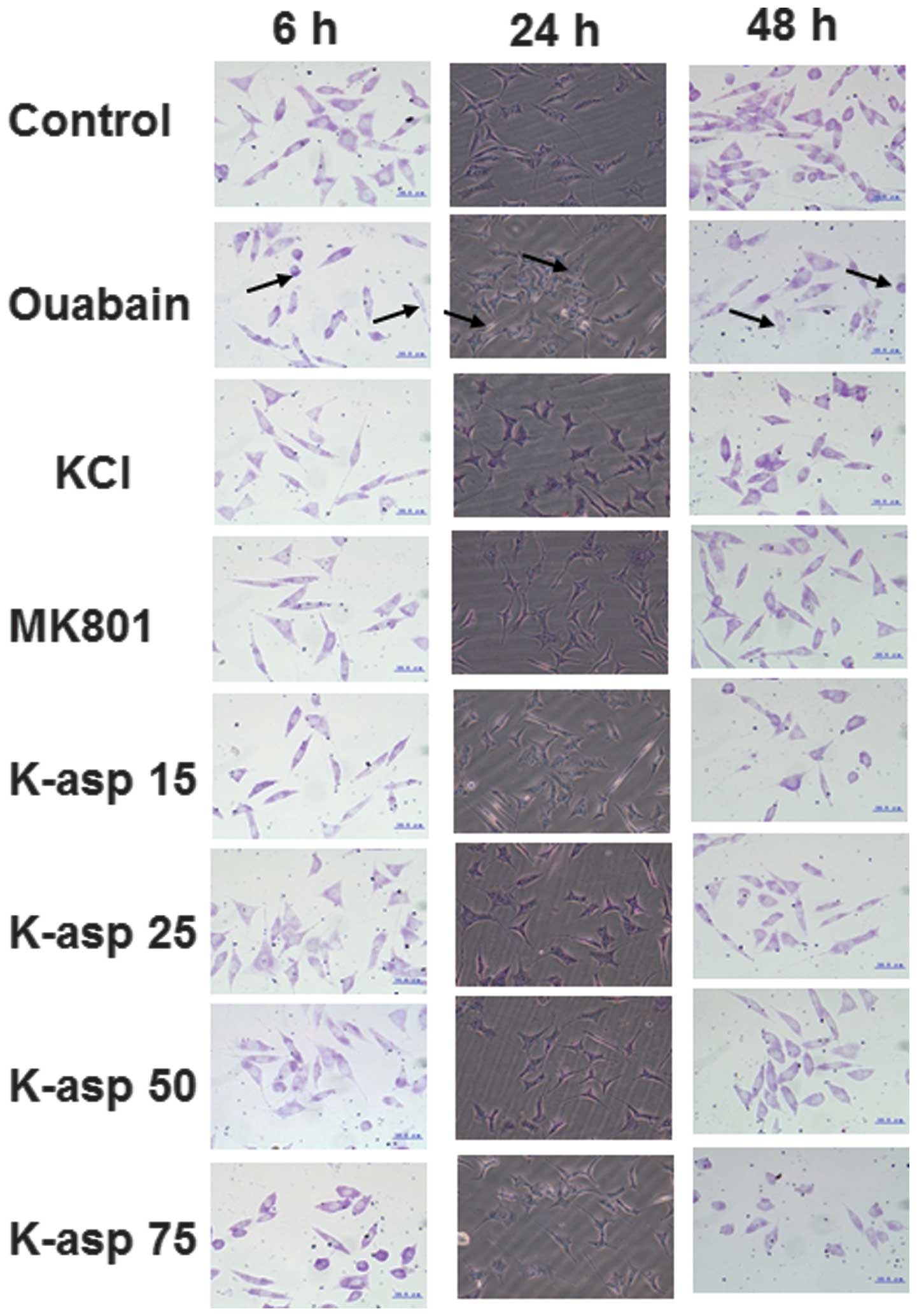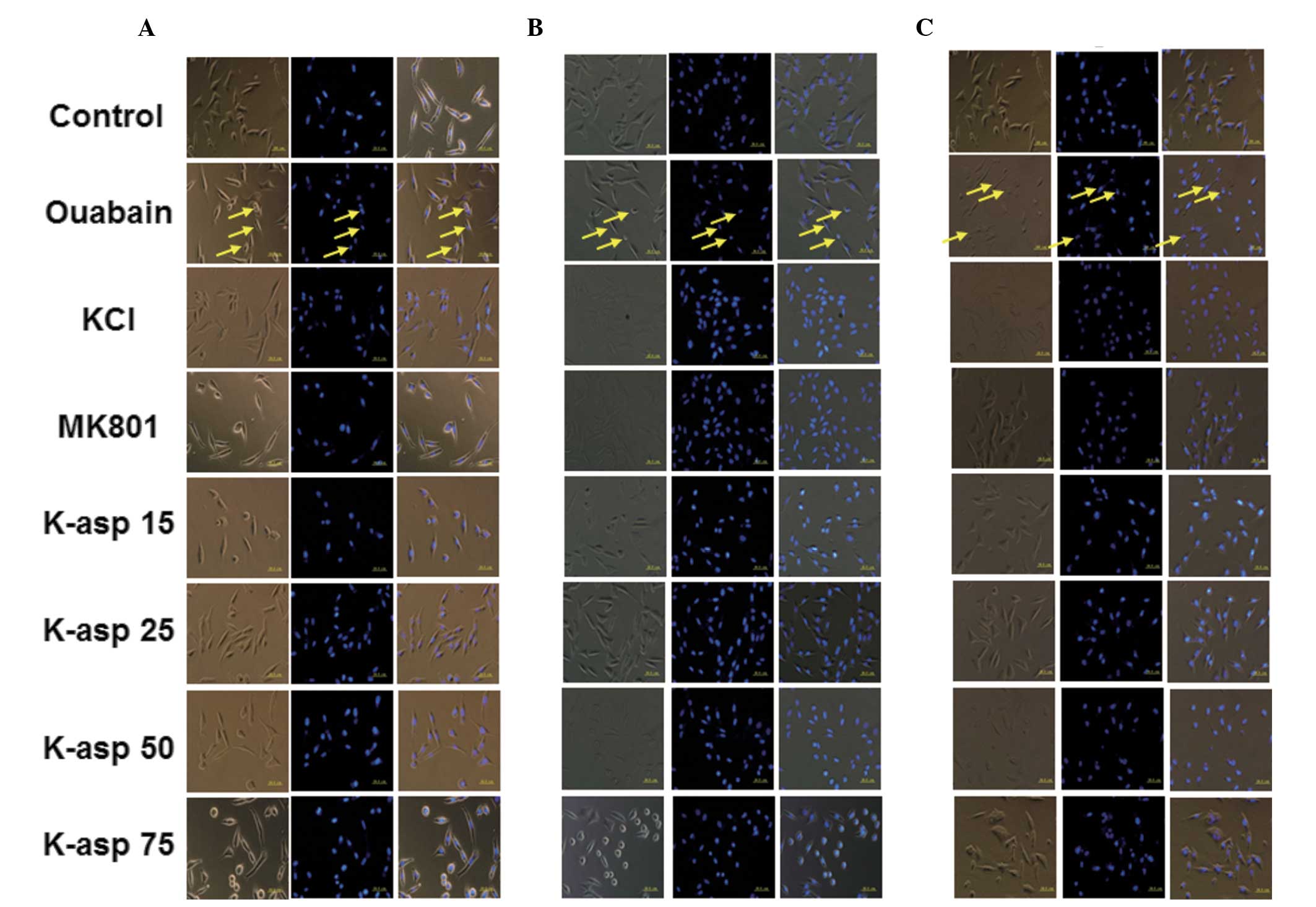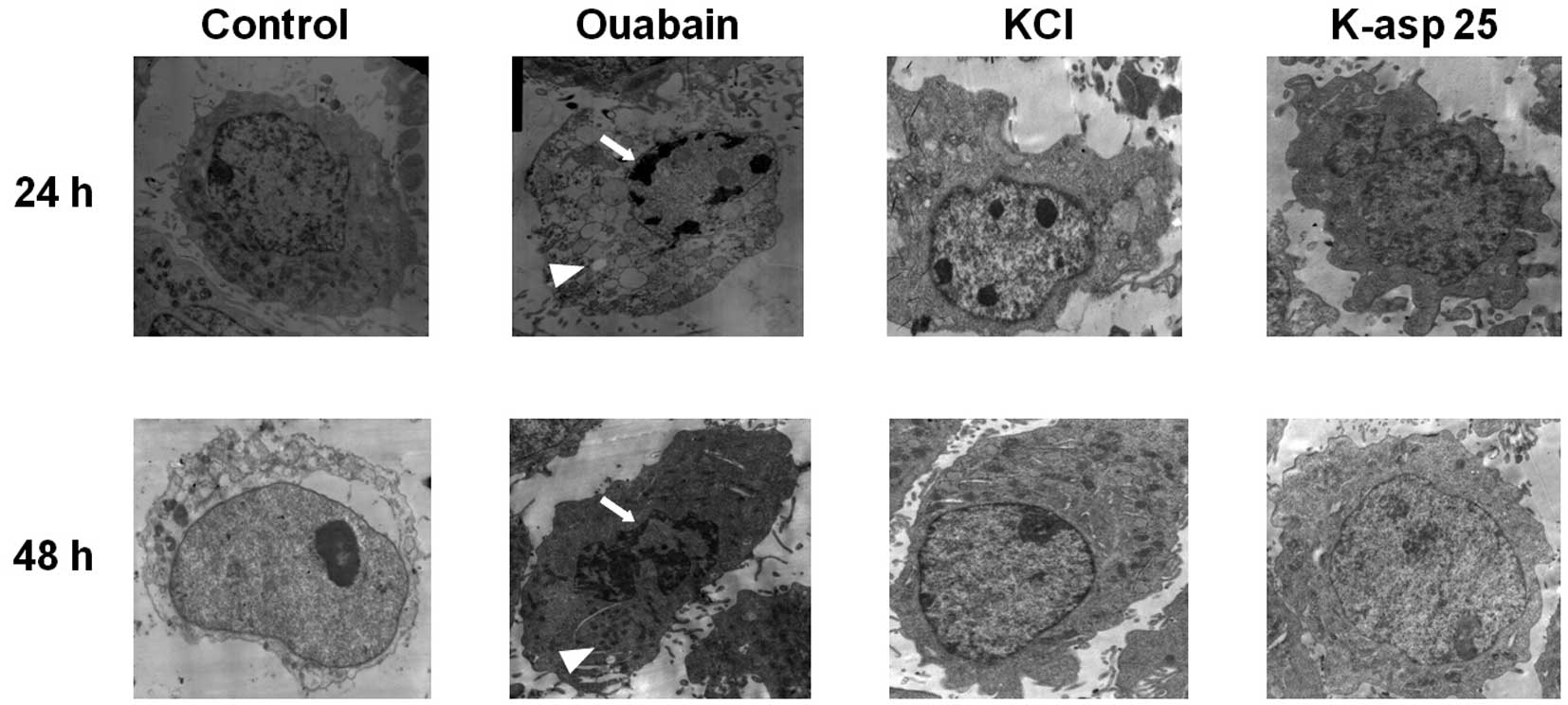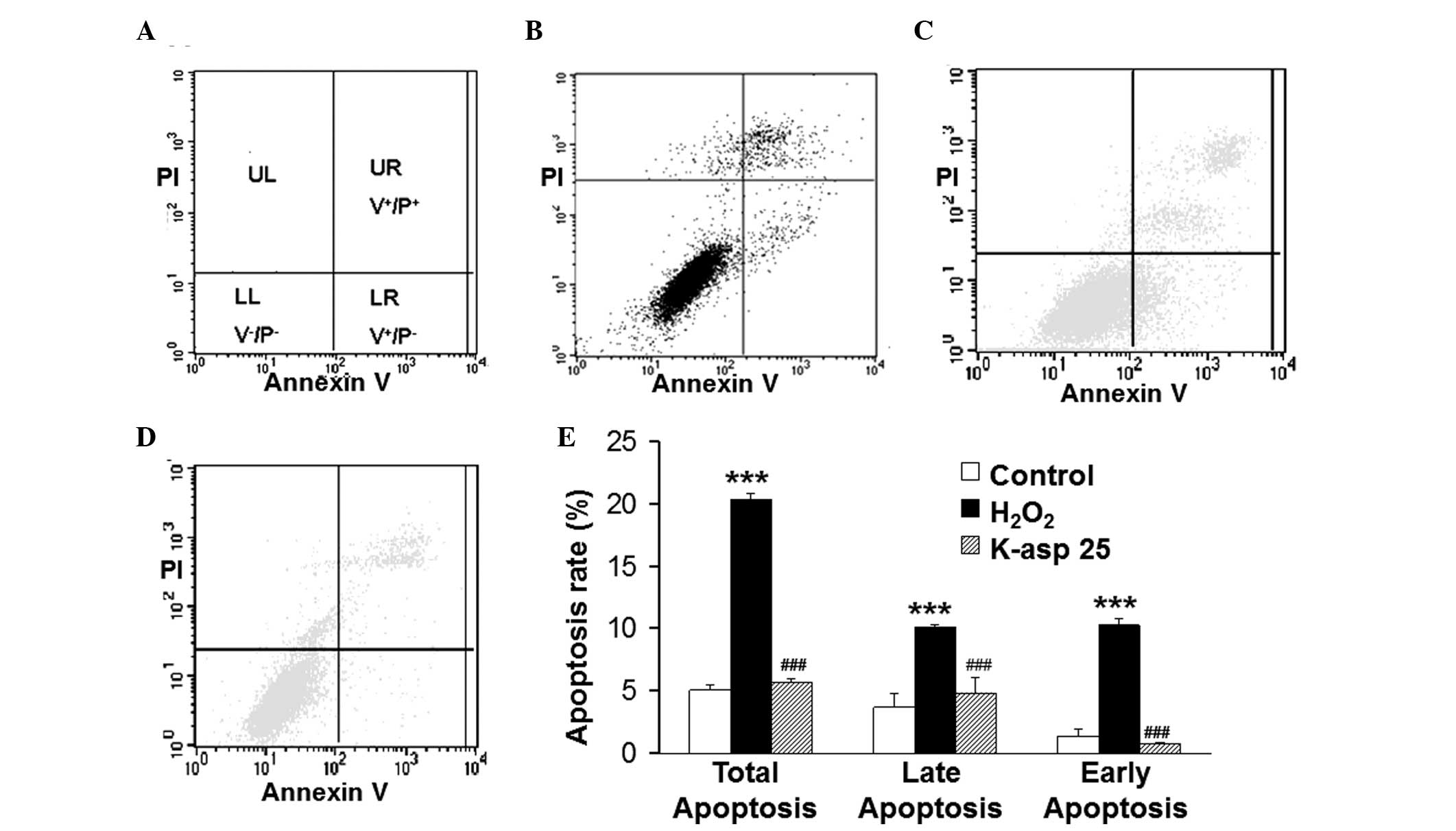Potassium aspartate inhibits SH‑SY5Y cell damage and apoptosis induced by ouabain and H2O2
- Authors:
- Published online on: May 7, 2015 https://doi.org/10.3892/mmr.2015.3741
- Pages: 2842-2848
Abstract
Introduction
The potassium ion (K+) is an important ion, which is involved in the metabolism of sugar and protein in a variety of cell types, and maintains the balance between the pH and osmolarity of cells. It is essential in the formation of resting potential, neuromuscular excitability and the maintenance of normal myocardial diastolic movement coordination (1). Hypokalemia is a common disease in which abnormal concentrations of K+ in the blood cause severe pathological changes, including muscle weakness, intestinal paralysis, sinus tachycardia, ventricular fibrillation and other arrhythmias (2). Hypokalemia is caused by various factors, including insufficient food, vomiting, severe diarrhea, kidney disease, digitalism and long-term use of glucocorticoids (3). The major treatment for hypokalemia is K+ supplementation. L-aspartic acid potassium salt (K-asp) is commonly used in the clinical treatment of hypokalemia (4,5), in which L-aspartic acid is used as the carrier to transport K+ into the cells (6). However, the protective effect of K-asp in nerve cells surrounded by a low potassium environment remains to be elucidated.
Several neurodegenerative diseases, including Alzheimer’s disease, Parkinson’s disease, amyotrophic lateral sclerosis, ischemia and excitotoxicity are associated with oxidative injury (7). Previous findings have indicated that oxidative damage may be associated with reactive oxygen species (ROS) and manifested by cell lysis, oxidative bursting or excessive quantities of free transition metals (8,9). H2O2 is one type of ROS, which has been used as an important reagent to establish an in vitro model of oxidative stress injury (10). Ouabain is an Na+ and K+-adenosine triphosphate (ATP)ase inhibitor, which can induce concentration-dependent neuronal cell death. Neuronal cell swelling is followed by cell shrinkage, which is accompanied by an increase in intracellular Na+ and decrease in K+ (11). In the present study, the anti-apoptotic effect of K-asp was investigated in ouabain-treated and H2O2-treated human SH-SY5Y cells.
Materials and methods
Cells and drugs
Human SH-SY5Y cells were obtained from American Type Culture Collection (Rockville, MD, USA) and were cultured in Dulbecco’s modified Eagle’s medium (Invitrogen Life Technologies, Carlsbad, CA, USA), supplemented with 10% fetal bovine serum (Gibco Life Technologies, Carlsbad, CA, USA) and 100 U/ml penicillin/streptomycin (Sigma-Aldrich, St. Louis, MO, USA). The cells were incubated in a humidified incubator at 37°C with 5% CO2, and the medium was replaced every 2 days. Ouabain (Sigma-Aldrich, St. Louis, MO, USA), H2O2 (Sigma-Aldrich), 25 mM KCl, 2 μM MK801 (Sigma-Aldrich) and 15, 25, 50 or 75 mM K-asp (Liaoning Union Pharmaceutical Co., Ltd., Liaoning, China) were dissolved in distilled water. KCl, MK801 and K-asp were added 4 h prior to treatment with either ouabain or H2O2. The present study was approved by the ethics committee of China Medical University (Shenyang, China).
Analysis of cell death using a 3-(4,5-dimethylthi-azol-2-yl)-2,5-diphenyltetrazolium bromide (MTT) assay
The human SH-SY5Y cells were plated into 96-well plates at a concentration of 5×103 cells/well and were incubated with KCl (25 mM), MK801 (2 μM) or K-asp (15 mM, 25 mM, 50 mM or 75 mM), at 37°C for 4 h, prior to the addition of ouabain (100 μM). Following treatment, the cells were incubated for 24 and 48 h. The cells were treated with MTT (0.5 mg/ml/well) for 4 h, prior to the MTT being replaced with 150 μl dimethyl sulfoxide (DMSO) and the absorption was determined at 570 nm using a spectrophotometric plate reader (680; Bio-Rad Laboratories, Inc., Hercules, CA, USA).
Nissl staining
The human SH-SY5Y cells (5×104) were plated into 24-well plates and incubated, as described above. Following incubation with 100 μM ouabain for 6, 24 or 48 h, the cells were fixed with 4% paraformaldehyde (Sinopharm Chemical Reagent Co., Ltd., Shanghai, China) and subsequently incubated in Nissl solution (1%) at room temperature for 12 min. The stained cells were observed under a light microscope (CK X41; Olympus, Tokyo, Japan).
Analysis of apoptosis using 4′,6-diamidino-2-phenylindole (DAPI) staining
The human SH-SY5Y cells (5×104) were plated onto a cover slip and incubated as described above. Following incubation with 100 μM ouabain for 24 or 48 h, the cells were fixed with 4% paraformaldehyde and incubated in DAPI solution (100 ng/ml) for 1 min in the dark. The stained cells were observed under a fluorescence microscope (BX61/DP71; Olympus).
Transmission electron microscopy
The cells were incubated as described above. Following incubation with 100 μM ouabain for 24 and 48 h, the cells were fixed using 4% gluteraldehyde (Sinopharm Chemical Reagent Co., Ltd.) in 0.1 M phosphate buffer (pH 7.4; Sinopharm Chemical Reagent Co., Ltd.), and postfixed with 1% osmioum tetroxide (Sinopharm Chemical Reagent Co., Ltd.) in 0.1 M cacodylate (Sinopharm Chemical Reagent Co., Ltd.) buffer for 1 h at 4°C. The cells (5×104) were subsequently dehydrated using ethanol (50, 70 and 90%), infiltrated using acetone and epoxy resin (Structure Probe, Inc., West Chester, PA, USA), and finally embedded in capsules (Agar Scientific, Essex, UK). Polymerization was performed at 60°C for 48 h. Thin sections were cut with a diamond knife on an ultramicrotome and mounted onto slot grids (Ted Pella, Inc., Redding, CA, USA). The unstained sections were observed under a Hitachi H-600 transmission electron microscope (Hitachi, Tokyo, Japan).
Flow cytometry
The cells (1×106) were incubated, as described above. Following incubation with 100 μM H2O2 for 48 h, the cells were collected into tubes and washed twice with 10 ml phosphate-buffered saline (PBS; Sinopharm Chemical Reagent Co., Ltd.). The cells (1×106 cells/sample) were stained with annexin V-fluorescein isothiocyanate (FITC)/propidium iodide (PI; BD Biosciences, San Jose, CA, USA), according to the manufacturer’s instructions (BD Biosciences, San Jose, CA, USA), and subsequently analyzed on a fluorescence-activated cell sorting instrument (FACSAsia; Becton Dickinson, Franklin Lakes, NJ, USA). The PI- and annexin V-negative cells (lower left quadrant) were considered to be normal, PI-negative and annexin V-positive cells (lower right quadrant) were considered early apoptotic cells, PI- and annexin V-positive cells (upper right quadrant) were considered late apoptotic cells, and the PI-positive and annexin V-negative cells (upper left quadrant) were considered mechanically injured. All experiments were performed in triplicate and representative figures produced.
Statistical analysis
The results were analyzed using SPSS 13.0 software (SPSS, Inc., Chicago, IL, USA). The data are expressed as the mean ± standard deviation. Two groups of mean values were compared using Student’s t-test. P<0.05 was considered to indicate a statistically significant difference.
Results
K-asp attenuates the cytotoxicity of ouabain on SH-SY5Y cells in a dose-dependent manner
To investigate the effect of K-asp on ouabain-induced cell death, an MTT assay was performed. The viability of the SH-SY5Y cells exposed to ouabain for 24 h was 65.89±3.41% of that in the control group. The viabilities of the cells treated with KCl, MK801, K-asp (25 mM) and K-asp (50 mM) were 93.21±3.67 (P<0.01), 84.49±1.89 (P<0.01), 91.32±1.75 (P<0.01) and 74.19±0.82% (P<0.05), respectively (Fig. 1A). The cells exposed to ouabain for 48 h was 88.37±9.08% of that of the control group. The viabilities of the cells treated with K-asp (15 and 25 mM) were 101.20±19.07 (P<0.05) and 101.40±12.54% (P<0.01), respectively (Fig. 1B). The data suggested that K-asp attenuated the ouabain-induced cytotoxicity of the SH-SY5Y cells in a dose-dependent manner.
K-asp decreases the severity of ouabain-induced necrosis in the SH-SY5Y cells, in a dose-dependent manner
To observe the morphological changes of the SH-SY5Y cells, Nissl staining was performed. Following incubation with ouabain for 6, 24 and 48 h, the control group exhibited few injured cells, and the visual field was predominantly clear and intact cells without cell necrosis. However, a significant proportion of the cells in the ouabain group were damaged, exhibiting extensive degenerative changes, including sparse cell arrangements, loss of integrity, a shrunken cytoplasm and swollen cell bodies (Fig. 2). The cells of the 48 h incubation group exhibited more severe injury compared with those in the 6 and 24 h incubation groups. By contrast, the severity of cell necrosis in the KCl, MK801, K-asp (15 mM) and K-asp (25 mM) groups was alleviated, whereas cell necrosis in K-asp (50 mM) and K-asp (75 mM) groups was not. These results suggested that K-asp alleviated the severity of ouabain-induced necrosis in the SH-SY5Y cells, in a dose-dependent manner.
K-asp ameliorates ouabain-induced apoptosis of SH-SY5Y cells, and 25 mM K-asp is the most effective concentration
To examine the apoptotic response of the SH-SY5Y cells incubated with ouabain for 6, 24 or 48 h, light microscopy and DAPI staining were performed. In the control group, the cell structures were clear, synapses were complete and large quantities of the stained nuclei were uniform and oval in shape. In the ouabain-treated group, the cell structures were unclear and the number of viable cells were reduced, with a large quantity of cell fragments. The nuclei were unevenly stained, their shape and size were irregular, and their number was significantly reduced. The number of cells in the ouabain-treated group, following incubation for 24 and 48 h, was significantly reduced compared with the control group. In the KCl group, light microscopy revealed that the cell structures were clear and few cells were round, and the results of the DAPI staining demonstrated that the number of the cells was increased. In the MK801 group, light microscopy revealed that the cell structures were clear and only a few cell fragments were observed, with the DAPI staining demonstrating few cell shape abnormalities. In the K-asp (25 mM) group, light microscopy revealed higher numbers of cells and fewer cell fragments, compared with the KCl, MK801, K-asp (15 mM) and K-asp (50 mM) groups (Fig. 3). These data demonstrated that K-asp ameliorated the ouabain-induced apoptosis of the SH-SY5Y cells, with K-asp (25 mM) being the most effective.
K-asp (25 mM) reduces cellular ultrastructure changes, induced by ouabain
To determine the effect of K-asp on ultrastructure changes of the SH-SY5Y cells following incubation with ouabain for 24 and 48 h, the cells were visualized using transmission electron microscopy. In the control group, the cell membrane and nuclear membrane were intact, and the structures of the mitochondria and endoplasmic reticulum were clear. The ouabain group exhibited incomplete cell membranes, cell shrinkage, nuclear cleavage fragments, sparse necrotic cell chromatin, irregular granular distribution, cell swelling and damage to the organelle structures. By contrast, the KCl group and K-asp (25 mM) group exhibited nuclear chromatin condensation, crescent- or ring-shaped nuclear membrane bodies and clear organelle structures (Fig. 4). These data suggested that KCl and K-asp (25 mM) alleviated the cellular ultrastructure changes, which were induced following treatment with ouabain.
K-asp (25 mM) ameliorates the apoptosis of SH-SY5Y cells induced by H2O2
To determine how K-asp affected H2O2-induced cell apoptosis, an annexin V-FITC/PI binding assay and flow cytometry were performed to detect cell apoptosis. In the double parameter dot plots (Fig. 5), an increased number of cells in the LR area were indicative of early apoptotic cells and those in the UR area were indicative late apoptotic cells (Fig. 5A). In the control group, the early apoptotic population of the SH-SY5Y cells was 1.38±0.50% and the late apoptotic population was 3.69±0.98%, combining to a total apoptotic population 5.07±0.87%. In the H2O2 group, the early apoptotic population of cells was 10.29±3.96% and the late apoptotic population was 10.09±0.85%, combining to a total apoptotic population 20.38±3.89%. The total number of apoptotic population of the cells in H2O2 group was significantly higher than that in the control group (P<0.001). In the K-asp (25 mM) group, the early apoptotic population of cells was 0.77±0.45% and the late apoptotic population was 4.89±1.56%, combining to a total apoptotic population of 5.66±1.98%. The total apoptotic population of the cells in K-asp (25 mM) group was significantly decreased, compared with the H2O2 group (P<0.001; Fig. 5E). These data demonstrated that K-asp (25 mM) ameliorated the apoptotic response of the-H2O2-induced SH-SY5Y cells.
Discussion
Ouabain is a Na+-K+-ATP enzyme inhibitor, which increases the levels of Na+ and Ca2+ and decreases the levels of K+ under intracellular conditions (11). In the early period of ouabain treatment (2–6 h), SH-SY5Y cells swell and the cell volume decreases gradually, resulting in cell apoptosis and necrosis (11). Previous studies have demonstrated that intracellular K+ concentrations are reduced to 80% in neurons treated with ouabain for 12 h (12–14). The present study demonstrated that, following treatment with ouabain for 24 h, the number of cells was significantly decreased and the cell survival rate was significantly increased in the KCl, MK801 and K-asp (25 mM) groups. No difference in cell survival rate was observed between the KCl and K-asp (25 mM) groups, and the cell survival rates in these two groups were higher compared with that in the MK801 group. The cell survival rates following incubation for 48 h in the K-asp (15 mM) and K-asp (25 mM) groups were higher compared with the KCl and MK801 groups. These results indicated that KCl had a short-term protective effect against cellular damage caused by low potassium, however, K-asp exhibited a longer duration of protective effects compared with KCl.
Nissl bodies indicate nerve cell functions (12). The results of the Nissl staining in the present study demonstrated that the cells in the KCl, MK801 and K-asp (25 mM) groups exhibited darker staining, compared with those in the ouabain group, with the number of cells being increased. This observation indicated that K-asp and KCl protected against ouabain-induced cell damage.
As a well-established model of in vitro SH-SY5Y cell oxidative stress, H2O2 can readily pass through the cell membrane and cause cell damage, resulting in the disturbance of ion homeostasis (15,16). H2O2 inhibits Na+-K+-pump activity and decreases intracellular levels of K+. A previous study demonstrated that apoptotic cell dehydration was caused by the loss of K+ (17). In cancerous tissues, fewer KV1.1 and KV1.3 potassium channels are expressed and the cell apoptosis is abnormal, indicating that potassium channels may contribute to apoptosis (18). Another previous study demonstrated cerebellar granule neuron apoptosis following the transfer of cells from different extracellular potassium concentrations (19). In the present study, K-asp (25 mM) protected the SH-SY5Y cells from the induction of apoptosis following incubation with H2O2 48 h. The total apoptotic population of the cells in the H2O2 group was significantly increased compared with the control group, however, this effect was suppressed following treatment with K-asp (25 mM). Subsequent analysis revealed that the protective effect of K-asp (25 mM) was persistent in the early and late periods of apoptosis. These results demonstrated that K-asp (25 mM) significantly reduced the apoptotic rate of the cells, however, excessively high K+ concentrations (≥50 mM) resulted in apoptosis. These results were consistent with those reported in previous studies (20,21).
It has been reported that ouabain inhibits the reduction in Bcl-2 and the increases the phosphorylation of the pro-apoptotic factor, p53, in SH-SY5Y cells (13). Ouabain, a Na+-K+-ATP enzyme inhibitor, increases levels of intracellular Na+ and promotes Na+-Ca2+ exchange, which causes intracellular calcium overload and activates caspase-3 and endogenous nucleases, leading to apoptosis and irreversible damage (11). In the present study, analysis using DAPI staining and transmission electron microscopy revealed that KCl and K-asp (25 mM) reduced the level of apoptosis induced by ouabain. The annexin V-FITC/PI binding assay indicated that K-asp (25 mM) also reduced apoptosis, which was induced by H2O2. In the present study, MK801, a NMDA receptor antagonist, reduced ouabain-induced cell damage caused.
Decreased intracellular ions lead to decreased intracellular osmotic crystals and the outflow of water molecules, causing a reduction in cell volume (19). This is partly consistent with the results of the present study. K-asp, a novel energy type potassium agent, has a high affinity towards cells. Aspartic acid contributes to the citric acid cycle to provide ATP for the body and to assist in Na+-K+-ATP enzyme recovery (22). In the present study, K-asp (15 mM and 25 mM) had a better protective effect compared with KCl, whereas the cells in the K-asp (75 mM) group exhibited severe damage, caused by the high concentration of K+ (23,24).
In conclusion, the present study demonstrated that K-asp (25 mM) had protective effects on the SH-SY5Y cells, with superior effects compared with KCl, following incubation for 48 h. This suggested that K-asp supplemented the levels of intracellular K+ and inhibited the apoptosis of the SH-SY5Y cells.
References
|
Abe K and Saito H: Involvement of Na+-K+ pump in L-glutamate clearance by cultured rat cortical astrocytes. Biol Pharm Bull. 23:1051–1054. 2000. View Article : Google Scholar : PubMed/NCBI | |
|
Ueno Y, Ogino Y and Kinouchi T: Sodium, potassium. Nihon Rinsho. 12:250–256. 2004.In Chinese. | |
|
Willard MD: Disorders of potassium homeostasis. Vet Clin North Am Small Anim Pract. 19:241–263. 1989. View Article : Google Scholar : PubMed/NCBI | |
|
Shiino A, Nishida Y, Yasuda H, Suzuki M, Matsuda M and Inubushi T: Magnetic resonance spectroscopic determination of a neuronal and axonal marker in white matter predicts reversibility of deficits in secondary normal pressure hydrocephalus. J Neurol Neurosurg Psychiatry. 75:1141–1148. 2004. View Article : Google Scholar : PubMed/NCBI | |
|
Suleiman MS, Dihmis WC, Caputo M, Angelini GD and Bryan AJ: Changes in myocardial concentration of glutamate and aspartate during coronary artery surgery. Am J Physiol. 272:H1063–H1069. 1997.PubMed/NCBI | |
|
Saunders EC, Ng WW, Chambers JM, et al: Isotopomer profiling of Leishmania mexicana promastigotes reveals important roles for succinate fermentation and aspartate uptake in tricarboxylic acid cycle (TCA) anaplerosis, glutamate synthesis and growth. J Biol Chem. 286:27706–27717. 2011. View Article : Google Scholar : PubMed/NCBI | |
|
Olanow CW and Tatton WG: Etiology and pathogenesis of Parkinson’s disease. Annu Rev Neurosci. 22:123–144. 1999. View Article : Google Scholar | |
|
Bellavite P: The superoxide-forming enzymatic system of phagocytes. Free Radic Biol Med. 4:225–261. 1988. View Article : Google Scholar : PubMed/NCBI | |
|
Halliwell B and Gutteridge JM: Lipid peroxidation in brain homogenates: the role of iron and hydroxyl radicals. J Neurochem. 69:1330–1331. 1997. View Article : Google Scholar : PubMed/NCBI | |
|
Gardner AM, Xu FH, Fady C, Jacoby FJ, Duffey DC, Tu Y and Lichtenstein A: Apoptotic vs. nonapoptotic cytotoxicity induced by hydrogen peroxide. Free Radic Biol Med. 22:73–83. 1997. View Article : Google Scholar : PubMed/NCBI | |
|
Xiao AY, Wei L, Xia S, Rothman S and Yu SP: Ionic mechanism of ouabain induced concurrent apoptosis and necrosis in individual cultured cortical neurons. Neuroscience. 22:1350–1362. 2002. | |
|
Huang X, Moir RD, Tanzi RE, Bush AI and Rogers JT: Redox-active metals, oxidative stress and Alzheimer’s disease pathology. Ann N Y Acad Sci. 1012:153–163. 2004. View Article : Google Scholar : PubMed/NCBI | |
|
Kulikov A, Eva A, Kirch U, Boldyrev A and Scheiner-Bobis G: Ouabain activates signaling pathways associated with cell death in human neuroblastoma. Biochim Biophys Acta. 1768:1691–1702. 2007. View Article : Google Scholar : PubMed/NCBI | |
|
Yu SP, Yeh C, Strasser U, Tian M and Choi DW: NMDA receptor mediated K+ efflux and neuronal apoptosis. Science. 284:336–339. 1999. View Article : Google Scholar : PubMed/NCBI | |
|
Wang XQ, Xiao AY, Sheline C, et al: Apoptotic insults impair Na+-K+-ATPase activity as a mechanism of neuronal death mediated by concurrent ATP deficiency and oxidant stress. J Cell Sci. 116:2099–2110. 2003. View Article : Google Scholar : PubMed/NCBI | |
|
Xiao AY, Wang XQ, Yang A and Yu SP: Slight impairment of Na+-K+-ATPase synergistically aggravates ceramide- and beta-amyloid-induced apoptosis in cortical neurons. Brain Res. 955:253–259. 2002. View Article : Google Scholar : PubMed/NCBI | |
|
Yurinskaya VE, Rubashkin AA and Vereninov AA: Balance of unidirectional monovalent ion fluxes in cells undergoing apoptosis: why does Na+-K+ pump suppression not cause cell swelling? J Physiol. 589:2197–2211. 2011. View Article : Google Scholar : PubMed/NCBI | |
|
Brevet M, Ahidouch A, Sevestre H, Merviel P, El Hiani Y, Robbe M and Ouadid-Ahidouch H: Expression of K+ channels in normal and cancerous human breast. Histol Histopathol. 23:965–972. 2008.PubMed/NCBI | |
|
Hernández-Enríquez B, Arellano RO and Morán J: Role for ionic fluxes on cell death and apoptotic volume decrease in cultured cerebellar granule neurons. Neuroscience. 167:298–311. 2010. View Article : Google Scholar : PubMed/NCBI | |
|
Huang XP, Tan H, Chen BY and Deng CQ: Astragalus extract alleviates nerve injury after cerebral ischemia by improving energy metabolism and inhibiting apoptosis. Biol Pharm Bull. 35:449–454. 2012. View Article : Google Scholar : PubMed/NCBI | |
|
Wang M, Qiu J, Mi W, Wang F and Qu J: In vitro effect of altering potassium concentration in artificial endolymph on apoptosis and ultrastructure features of olfactory bulb neural precursor cells. Neurosci Lett. 487:383–388. 2011. View Article : Google Scholar | |
|
Jorgensen PL and Pedersen PA: Structure-function relationships of Na+, K+, ATP, or Mg2+ binding and energy transduction in Na, K-ATPase. Biochim Biophys Acta. 1505:57–74. 2001. View Article : Google Scholar : PubMed/NCBI | |
|
Gugliotta T, De Luca G, Romano P, Rigano C, Scuteri A and Romano L: Effects of lead chloride on human erythrocyte membranes and on kinetic anion sulphate and glutathione concentrations. Cell Mol Biol Lett. 17:586–597. 2012. View Article : Google Scholar : PubMed/NCBI | |
|
Noguchi T, Kamiyama N and Kashiwayanagi M: Modulation of voltage-gated ion channels on SH-SY5Y neuroblastoma by non-ionic surfactant, Cremophor EL. Biol Pharm Bull. 33:2013–2017. 2010. View Article : Google Scholar : PubMed/NCBI |



